
Uyuni Adventure


My 2006 trip was the first time I was leaving the familiar Bolivia I grew up knowing. Over the years away in the US, I accumulated dozens of anecdotes from tourists to this rugged part of the world. Their stories taunted me. I wanted an adventure and Uyuni delivered. My cousin and I set off from Oruro and a ten hour train ride later arrived in Uyuni. The harsh wind and thin air hit my senses. It was three in the morning and the town was deserted except for the dozens of tourists descending from the Wara Wara train. We looked for a place to park ourselves and wait for daylight.
Sitting at the doorsteps of a closed café, we caught up on our adventure. In Oruro we bought the last two seats on that train. One was in the ‘executive’ cabin, the other with the ‘carga’, my cousin took the latter. We figured that it didn’t matter, that we would be able to find each other at the food carte and spend the ride sipping coffee. I kept my end once we got going and went from one carte to the other, then the other, and so on with no luck of finding either the food carte or my cousin. Sitting next to her now I found that she had been locked in her carte for the entirety of her ride. In this carte she had been faced with no heat, livestock and anger from the crowds that weren’t able to get a ticket on board. They had eventually started throwing rocks at the train and a small child had been hit by the brocken glass. They had been able to help the child and once the train gained distance from the crowds, things settled and my cousin slept curled next to a ‘cholita’.
The sun was shining now, although it didn’t seem to warm our muscles much. We wondered around town looking for a guided tour. Our choice was random, there was no way to tell good from bad and we let ourselves take a chance. Getting out of the town of Uyuni took some waiting. The Landrover transformer car needed to be full before they would let it depart. At last an Australian, a Japanese, two Colombians and two Germans joined our troop and we were off. Our first stop was the Salt Hotel. I had insisted on spending a night there, thinking that a night on a salt hotel would probably be a unique experience. So it was. We were the only ones in our troop that had opted for this, and as we saw the rest of our companions leave I could feel a dash of apprehension on my cousin’s face.


The Uyuni Salt Flat is one of the largest in the world extending over four thousand square miles. It is also a desert resting on a plateau nearly twelve thousand feet above sea level. As the sun hid behind the horizon the frigid air took over. Our rooms had two beds made of salt of course. The cover was made of llama hides and hinted at flea infestation. Soon the need to relieve myself took over and I ventured to the bathrooms. And there it was, the single most important reason why no one should ever spend the night at the Salt Hotel. No running water and no drainage. The putrid smell was enough to sicken the most experienced traveler. I was not even in that league.
The next morning we felt the desolation that engulfs the communities in this part of the world. We waited and waited for our tour to pick us up and take us to the next destination. By early afternoon we were beginning to feel abandoned and started to plan for our escape. One of the other tours had to take pitty on us. But as we lost hope, finally we were rescued and a new band of travelers was formed. In this three Bolivians from Tarija, Chapacas as they are known, a Swiss, two Argentinians and us. And just like that our luck changed.
The next two days were filled with laughter and wonder. We hiked to the caldera of a dormant volcano, saw mummified remains and a small town that cultivated the skirts of this giant. We traveled to an island of cacti that served as the setting for a touristy bar. There were many more twists and turns in this story, but the most memorable were the long nights spent awake with our new found friends. Drinking and laughing, talking about how we could make this place better.
A few years later when I was back in Bolivia, I took another trip to Uyuni. This time I made reservations ahead of time in La Paz. The trip was wonderful and we visited all the lagoons and saw magnificent wildlife. It was perfect, but it was my first trip that continues to give me the best anecdotes.



